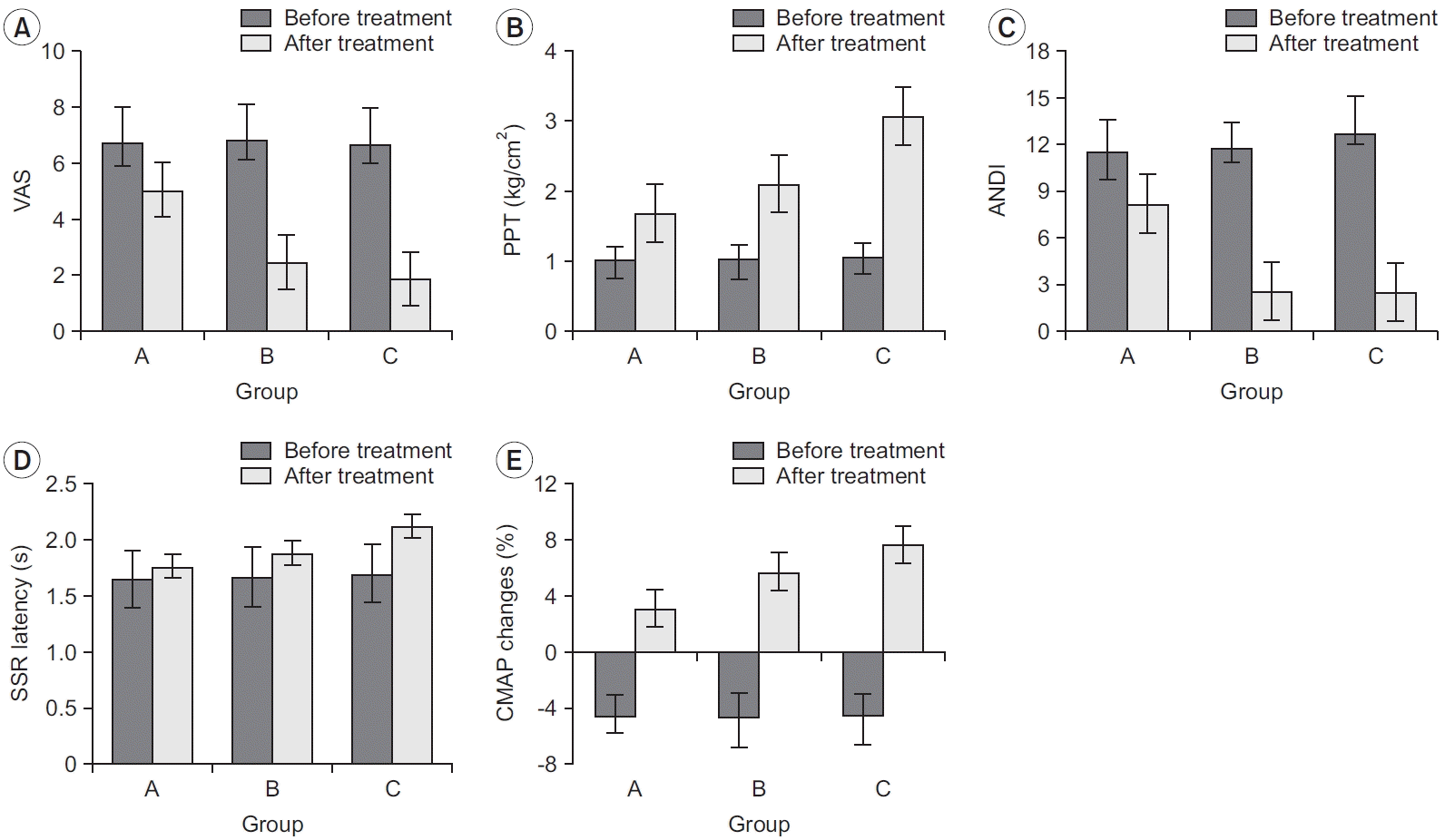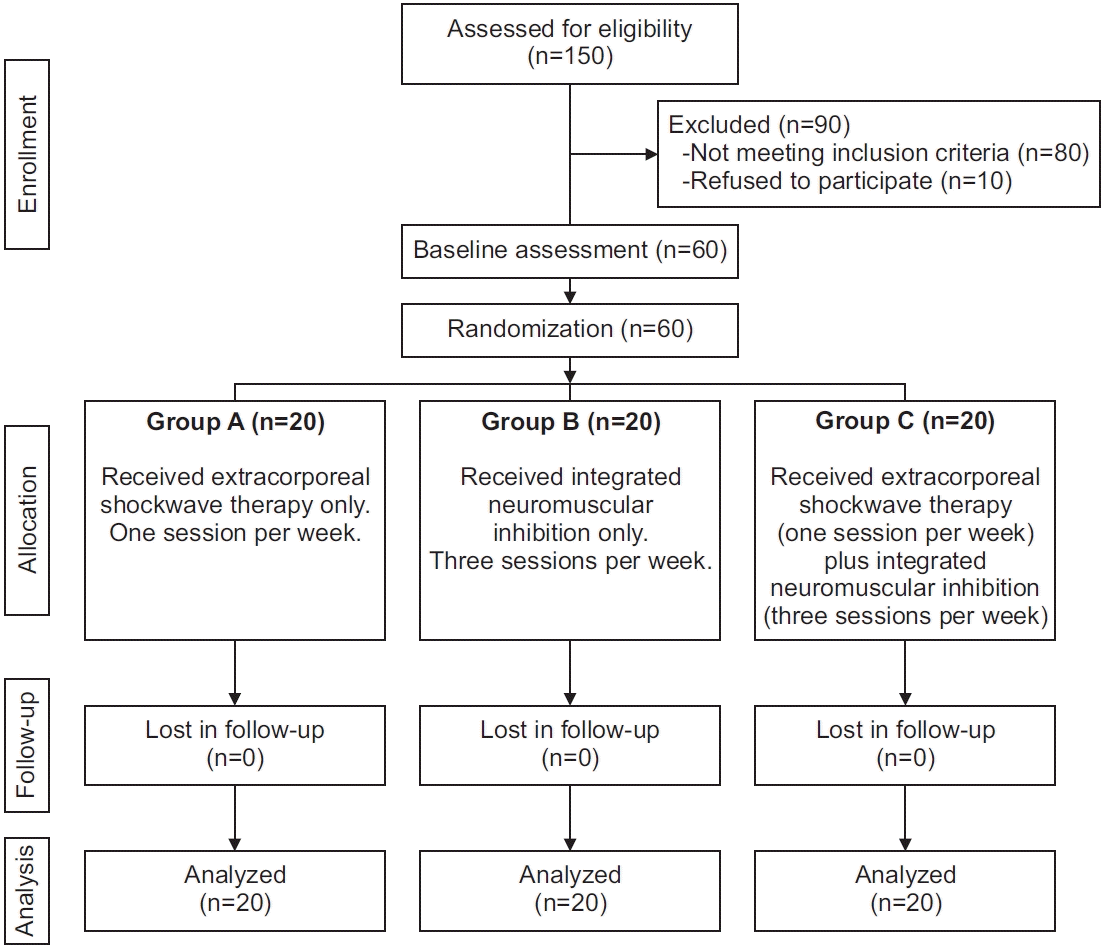1. Klein R, Bareis A, Schneider A, Linde K. Straincounterstrain to treat restrictions of the mobility of the cervical spine in patients with neck pain: a shamcontrolled randomized trial. Complement Ther Med. 2013; 21:1–7.
2. Rachlin ES, Rachlin IS. Myofascial pain and fibromyalgia: trigger point management. St. Louis, MO: Mosby;2002.
3. Martin-Herrero C, Rodrigues de Souza DP, Alburquerque-Sendin F, Ortega-Santiago R, Fernandez-de-LasPenas C. [Myofascial trigger points, pain, disability and quality of sleep in patients with chronic tensiontype headache: a pilot study]. Rev Neurol. 2012; 55:193–9.
4. Nagrale AV, Glynn P, Joshi A, Ramteke G. The efficacy of an integrated neuromuscular inhibition technique on upper trapezius trigger points in subjects with non-specific neck pain: a randomized controlled trial. J Man Manip Ther. 2010; 18:37–43.

5. Abbaszadeh-Amirdehi M, Ansari NN, Naghdi S, Olyaei G, Nourbakhsh MR. Neurophysiological and clinical effects of dry needling in patients with upper trapezius myofascial trigger points. J Bodyw Mov Ther. 2017; 21:48–52.

6. Unalan H, Majlesi J, Aydin FY, Palamar D. Comparison of high-power pain threshold ultrasound therapy with local injection in the treatment of active myofascial trigger points of the upper trapezius muscle. Arch Phys Med Rehabil. 2011; 92:657–62.

7. Simons DG. Review of enigmatic MTrPs as a common cause of enigmatic musculoskeletal pain and dysfunction. J Electromyogr Kinesiol. 2004; 14:95–107.

8. Hong CZ, Simons DG. Pathophysiologic and electrophysiologic mechanisms of myofascial trigger points. Arch Phys Med Rehabil. 1998; 79:863–72.

9. Simons DG, Hong CZ, Simons LS. Endplate potentials are common to midfiber myofacial trigger points. Am J Phys Med Rehabil. 2002; 81:212–22.

10. Vernon H, Schneider M. Chiropractic management of myofascial trigger points and myofascial pain syndrome: a systematic review of the literature. J Manipulative Physiol Ther. 2009; 32:14–24.

11. Sarrafzadeh J, Ahmadi A, Yassin M. The effects of pressure release, phonophoresis of hydrocortisone, and ultrasound on upper trapezius latent myofascial trigger point. Arch Phys Med Rehabil. 2012; 93:72–7.

12. Cagnie B, Dewitte V, Barbe T, Timmermans F, Delrue N, Meeus M. Physiologic effects of dry needling. Curr Pain Headache Rep. 2013; 17:348.

13. Cagnie B, Castelein B, Pollie F, Steelant L, Verhoeyen H, Cools A. Evidence for the use of ischemic compression and dry needling in the management of trigger points of the upper trapezius in patients with neck pain: a systematic review. Am J Phys Med Rehabil. 2015; 94:573–83.
14. Hong CZ, Chen YC, Pon CH, Yu J. Immediate effects of various physical medicine modalities on pain threshold of an active myofascial trigger point. J Musculoskelet Pain. 1993; 1:37–53.

15. Kietrys DM, Palombaro KM, Azzaretto E, Hubler R, Schaller B, Schlussel JM, et al. Effectiveness of dry needling for upper-quarter myofascial pain: a systematic review and meta-analysis. J Orthop Sports Phys Ther. 2013; 43:620–34.

16. Pecos-Martin D, Montanez-Aguilera FJ, Gallego-Izquierdo T, Urraca-Gesto A, Gomez-Conesa A, Romero-Franco N, et al. Effectiveness of dry needling on the lower trapezius in patients with mechanical neck pain: a randomized controlled trial. Arch Phys Med Rehabil. 2015; 96:775–81.
17. Kim DH, Yoon DM, Yoon KB. The effects of myofascial trigger point injections on nocturnal calf cramps. J Am Board Fam Med. 2015; 28:21–7.

18. Ogden JA, Alvarez RG, Levitt R, Marlow M. Shock wave therapy (Orthotripsy) in musculoskeletal disorders. Clin Orthop Relat Res. 2001; (387):22–40.

19. Gur A, Koca I, Karagullu H, Altindag O, Madenci E, Tutoglu A, et al. Comparison of the effectiveness of two different extracorporeal shock wave therapy regimens in the treatment of patients with myofascial pain syndrome. Turk J Rheumatol. 2014; 29:186–93.
20. Berta L, Fazzari A, Ficco AM, Enrica PM, Catalano MG, Frairia R. Extracorporeal shock waves enhance normal fibroblast proliferation in vitro and activate mRNA expression for TGF-beta1 and for collagen types I and III. Acta Orthop. 2009; 80:612–7.
21. Ochiai N, Ohtori S, Sasho T, Nakagawa K, Takahashi K, Takahashi N, et al. Extracorporeal shock wave therapy improves motor dysfunction and pain originating from knee osteoarthritis in rats. Osteoarthritis Cartilage. 2007; 15:1093–6.

22. Sibby GM, Kavitha Vishal S. Effectiveness of integrated neuromuscular inhibitory technique and LASER with stretching in the treatment of upper trapezius trigger points. J Exerc Sci Physiother. 2009; 5:115–21.
23. Chaitow L, DeLany J. Modern neuromuscular techniques. Edinburgh, UK: Churchill Livingstone;1996.
24. Fleckenstein J, Zaps D, Ruger LJ, Lehmeyer L, Freiberg F, Lang PM, et al. Discrepancy between prevalence and perceived effectiveness of treatment methods in myofascial pain syndrome: results of a cross-sectional, nationwide survey. BMC Musculoskelet Disord. 2010; 11:32.

25. Gilani MH, Obaid S, Tariq M. Comparison between effectiveness of ischemic compression and muscle energy technique in upper trapezius myofascial trigger points. ISRA Med J. 2018; 10:230–4.
26. Price DD, McGrath PA, Rafii A, Buckingham B. The validation of visual analogue scales as ratio scale measures for chronic and experimental pain. Pain. 1983; 17:45–56.

27. Lluch E, Arguisuelas MD, Coloma PS, Palma F, Rey A, Falla D. Effects of deep cervical flexor training on pressure pain thresholds over myofascial trigger points in patients with chronic neck pain. J Manipulative Physiol Ther. 2013; 36:604–11.

28. Takala EP. Pressure pain threshold on upper trapezius and levator scapulae muscles. Repeatability and relation to subjective symptoms in a working population. Scand J Rehabil Med. 1990; 22:63–8.
29. Shaheen AA, Omar MT, Vernon H. Cross-cultural adaptation, reliability, and validity of the Arabic version of neck disability index in patients with neck pain. Spine (Phila Pa 1976). 2013; 38:E609–15.

30. Childs JD, Cleland JA, Elliott JM, Teyhen DS, Wainner RS, Whitman JM, et al. Neck pain: clinical practice guidelines linked to the International Classification of Functioning, Disability, and Health from the Orthopedic Section of the American Physical Therapy Association. J Orthop Sports Phys Ther. 2008; 38:A1–A34.
31. Ramon S, Gleitz M, Hernandez L, Romero LD. Update on the efficacy of extracorporeal shockwave treatment for myofascial pain syndrome and fibromyalgia. Int J Surg. 2015; 24(Pt B):201–6.

32. Jagad BH, Jagad KB. Effects of ischemic compression on the trigger points in the upper trapezius muscle. Indian J Physiother Occup Ther. 2013; 7:99–104.
33. Lytras DE, Sykaras EI, Christoulas KI, Myrogiannis IS, Kellis E. Effects of exercise and an integrated neuromuscular inhibition technique program in the management of chronic mechanical neck pain: a randomized controlled trial. J Manipulative Physiol Ther. 2020; 43:100–13.

34. Peters D, Chaitow L, Harris G, Morrison S. Integrating complementary therapies in primary care: a practical guide for health professionals. Edinburgh, UK: Churchill Livingstone;2002.
35. Mahajan R, Kataria C, Bansal K. Comparative effectiveness of muscle energy technique and static stretching for treatment of subacute mechanical neck pain. Int J Health Rehabil Sci. 2012; 1:16–21.

36. Speed CA. Extracorporeal shock-wave therapy in the management of chronic soft-tissue conditions. J Bone Joint Surg Br. 2004; 86:165–71.

37. Ji HM, Kim HJ, Han SJ. Extracorporeal shock wave therapy in myofascial pain syndrome of upper trapezius. Ann Rehabil Med. 2012; 36:675–80.

38. Hong JO, Park JS, Jeon DG, Yoon WH, Park JH. Extracorporeal shock wave therapy versus trigger point injection in the treatment of myofascial pain syndrome in the quadratus lumborum. Ann Rehabil Med. 2017; 41:582–8.

39. Rahbar M, Samandarian M, Salekzamani Y, Khamnian Z, Dolatkhah N. Effectiveness of extracorporeal shock wave therapy versus standard care in the treatment of neck and upper back myofascial pain: a single blinded randomized clinical trial. Clin Rehabil. 2021; 35:102–13.
40. Kamel FH, Basha M, Alsharidah A, Hewidy IM, Ezzat M, Aboelnour NH. Efficacy of extracorporeal shockwave therapy on cervical myofascial pain following neck dissection surgery: a randomized controlled trial. Ann Rehabil Med. 2020; 44:393–401.

41. Janig W. The sympathetic nervous system in pain: physiology and pathophysiology. In : Stanton-Hicks MD, editor. Pain and the sympathetic nervous system. Boston, MA: Kluwer Academic Publishers;1990. p. 17–89.
42. Okuyucu EE, Turhanoglu AD, Guntel M, Yilmazer S, Savas N, Mansuroglu A. Does transcutaneous nerve stimulation have effect on sympathetic skin response? J Clin Neurosci. 2018; 47:160–2.

43. Alghadir AH, Iqbal A, Anwer S, Iqbal ZA, Ahmed H. Efficacy of combination therapies on neck pain and muscle tenderness in male patients with upper trapezius active myofascial trigger points. Biomed Res Int. 2020; 2020:9361405.

44. Nasb M, Qun X, Ruckmal Withanage C, Lingfeng X, Hong C. Dry cupping, ischemic compression, or their combination for the treatment of trigger points: a pilot randomized trial. J Altern Complement Med. 2020; 26:44–50.






 PDF
PDF Citation
Citation Print
Print




 XML Download
XML Download